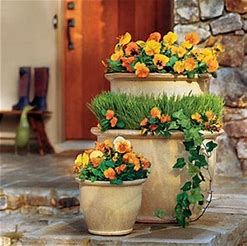CREATING A POT GARDEN
Most gardeners have a few things in pots, because they haven’t anywhere else to grow desired plants or they think a particular plant will grow better in a pot. Almost anything will grow in a pot, if all the right conditions are provided, but that may require considerable time, effort and expense. It’s probably better to choose plants carefully so that nothing becomes a burden. Plants ideally suited to pots include herbs like thyme, oregano, parsley and chives, succulents and cacti, pelargoniums and geraniums, and dwarf forms of native plants – kangaroo paw, banksia, acacia and correa.
Arranging pots together, with the smaller at the edges, can make a pleasing picture as well as making watering easier, and produce a healthier micro-climate. It would be a good idea to place pots needing similar watering regimes together, eg. succulents and cacti. Plants as tough as these are good for a sunny spot facing north or west. Smaller growing bulbs also make good container subjects, as they can be moved out of the way after flowering whilst their leaves die down.
Use a good quality potting mix (for natives if required), adding a bit of garden soil (for bulk) and/or coirpeat (for water retention). Covering the drainage hole with a piece of 50 per cent shade cloth works well. There will be some glazed and unglazed pots on the February monthly meeting trading table. (G. Crowhurst (2018) February Cuttings)

PLANTING BY THE MOON
The lunar month is 28 days, so it rarely corresponds with a calendar month. The first week (new to half-moon) is a good time to plant leafy annuals; the second week (half to full-moon) good for fruiting annuals, e.g. tomatoes, beans, with some things doing equally well if started in either the first or second week – annuals flowers, cucumbers, melons & leeks; the week after full moon is good for root crops, perennials, trees & shrubs, bulbs; the final week is a poor time to plant, so instead kill weeds, make compost, do garden maintenance.
FEBRUARY AND MARCH
Full moons occur on 11th February and 13th March, making the periods for garden maintenance only 19th- 27th February and 21st- 28th March. The best time for sowing and transplanting are as follows:
Leaf crops: 27th- 28th February and 2nd- 4th, 30th – 31st March
Fruiting crops: 7th – 8th March
Roots crops/perennials/shrubs/bulbs: February 14th – 18th, March 13th – 18th.
From Cuttings (Member’s Newsletter) February 2017
PLANTING BY THE MOON
The lunar month is 28 days, so it rarely corresponds with a calendar month. The first week (new to half-moon) is a good time to plant leafy annuals; the second week (half to full-moon) good for fruiting annuals, e.g. tomatoes, beans, with some things doing equally well if started in either the first or second week – annuals flowers, cucumbers, melons & leeks; the week after full moon is good for root crops, perennials, trees & shrubs, bulbs; the final week is a poor time to plant, so instead kill weeds, make compost, do garden maintenance.
May – June
Full moon 11th May and 9th June, so maintenance only time in the garden the weeks 19-16 May and 17-24 June. Best times for sowing:
Leafy annuals: 28-29 May, 25-26 June
Fruiting annuals: 4-8 June
Root crops, perennials, trees & shrubs: 11-13 & 16-17 June Transplanting seedlings: 28 May – 9 June
From Cuttings (May 2017)
When to prune salvias?
This is a fairly common question. Although there is a huge range of salvias, most commonly grown types flower from spring to late autumn. They are best given a good prune when they start to make growth in late winter/spring (later if there is frost). Ones that shoot from the base can have all the old stems cut out, and the more shrubby ones cut to new shoots lower down, with some old stems cut out altogether. The less commonly grown herbaceous salvias such as ‘Blue Hills’, ‘East Friesland’ and ‘Lubecca’ can be cut to near ground level from May onwards. Lambley Nursery sells a number of these, and Bulleen Art & Garden also have some from time to time.
After Christmas the herbaceous salvias are best cut right down again, for autumn flowering. Other salvias that flower into autumn can be trimmed or at least dead-headed in late summer, for a good flowering later. Some salvias, like ‘Wendy’s Wish’, are best lightly trimmed right through the flowering season to keep them bushy. If a salvia re-blooms quickly, the more often it can be trimmed.
A few members grow the late autumn to spring flowering South American salvias that can grow very large. One example is ‘Pink Icicles’. These limp through summer and then burst into growth with the cooler weather. They can be trimmed to promote side growth earlier on, and then cut to new shoots lower down after flowering.
From Cuttings (Member’s Newsletter) March 2017
